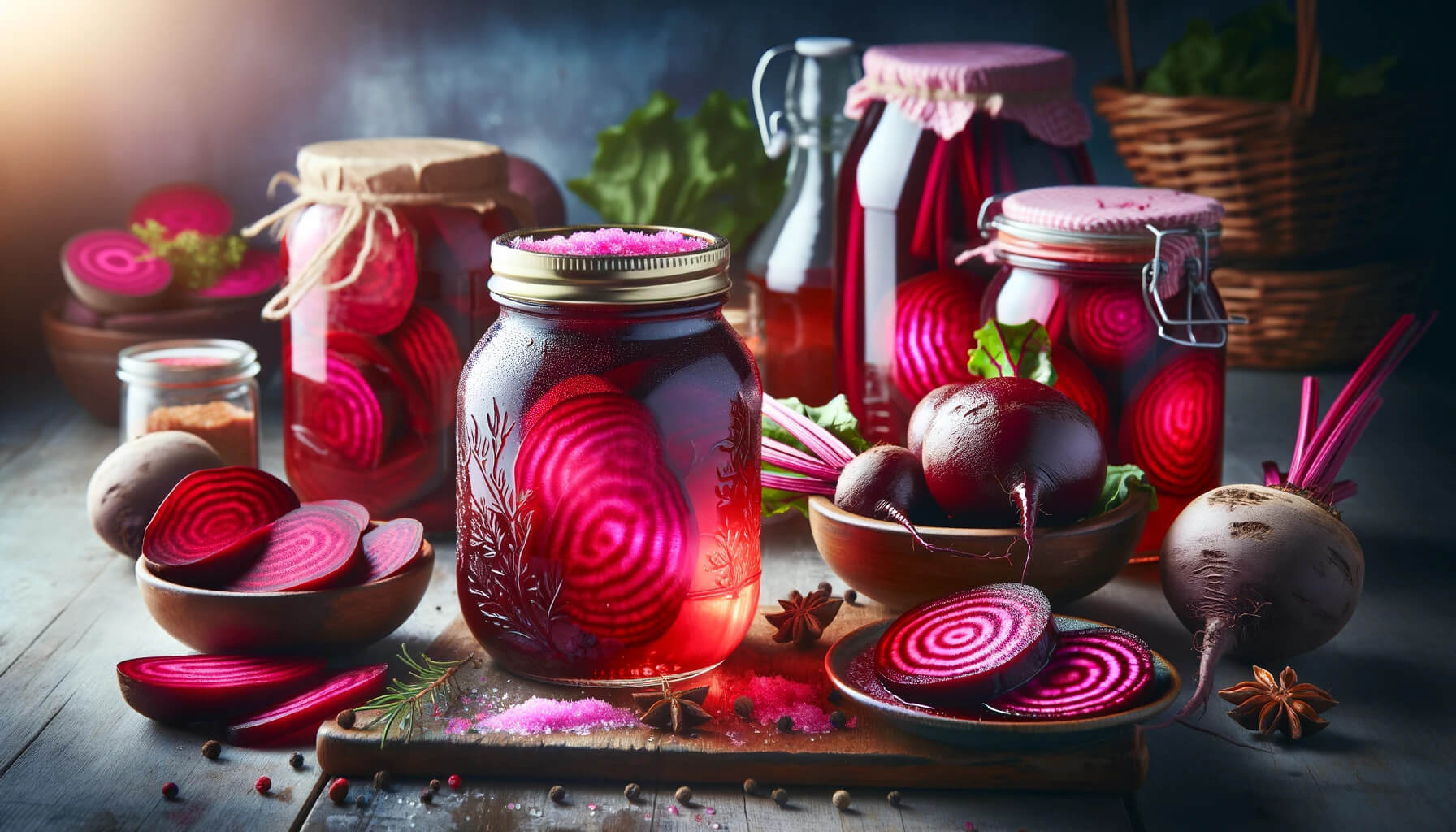Pickled Beets

Ingredients
- Beets (about 4 dozen)
- 9 cups apple cider vinegar (with mother)
- 5 cups water
- 4¾ cups sugar
Instructions
Prepare the Beets: Place the washed beets in a large container with water. Bring to a boil and cook until the skin slips off easily, at least 20 minutes. Then, pour cold water over the beets to cool.
Peel and Cut: Once cooled, peel the beets and cut them into your preferred size and shape. Pack them tightly into jars.
Make the Pickling Solution: In a saucepan, combine the apple cider vinegar, water, and sugar. Bring the mixture to a boil, ensuring the sugar is completely dissolved.
Jar the Beets: Pour the hot pickling solution over the packed beets in jars, leaving a small headspace. Seal the jars with lids.
Process: Process the jars in boiling water for 15-20 minutes to ensure they're sealed and preserved properly.
Cool and Store: Let the jars cool at room temperature. Check seals, then store in a cool, dark place.
For Canned Beets Variation: Reduce the recipe by ⅓ if using canned beets. Use 6 cans of beets, drained. Pour the hot pickling mixture over them and let them marinate in the refrigerator for a few days before consuming.
The Art and Science of Pickling
Diving into “The Art and Science of Pickling” is like embarking on a culinary adventure that spans across cultures, timelines, and flavors. This ancient practice, which originated as a method to preserve food beyond its natural shelf life, has evolved into a craft celebrated by chefs and home cooks alike for its ability to transform the taste and texture of ingredients, from crisp vegetables to succulent meats and even fruits.
The Science Behind Pickling
At the heart of pickling lies the science of fermentation and preservation. The process typically involves submerging the food in a solution of vinegar or brine (saltwater), which creates an environment where bacteria cannot thrive. In fermentation, beneficial bacteria (most notably Lactobacillus in many cases) break down sugars and produce lactic acid, which acts as a natural preservative. This not only extends the shelf life of the food but also enriches it with probiotics, vitamins, and minerals. The acidic environment of vinegar-based pickles offers a similar preservation benefit, with the added tanginess enhancing the food’s flavor profile.
The Art of Flavor Transformation
The artistry in pickling comes from the endless combinations of spices, herbs, and brining solutions that can be used to achieve different flavors and textures. Each ingredient choice—from the type of vinegar or the salt concentration in the brine, to the addition of sugar, garlic, dill, or other spices—can dramatically alter the final product. This creative freedom allows for a vast spectrum of pickled goods, ranging from the classic dill pickle to exotic delights like kimchi, sauerkraut, and pickled ginger. The pickling process itself becomes a canvas for culinary expression, inviting experimentation and innovation.
Cultural Significance and Culinary Uses
Pickling holds a revered place in many cultures around the world, each with its unique methods and cherished recipes passed down through generations. In Korea, kimchi is a staple at every meal, while in Eastern Europe, pickled cucumbers and sauerkraut are essential to the traditional diet. In India, a wide array of pickles made from mango, lime, and other fruits and vegetables accompany meals, adding bursts of flavor.
Beyond their role as a side dish or condiment, pickled foods have found their way into the heart of culinary creations. Chefs use pickled vegetables to add acidity and crunch to salads, sandwiches, and tacos, or as a counterbalance to rich, savory dishes. The bright, tangy flavors of pickled ingredients can elevate a dish, providing depth and complexity that delights the palate.
The Joy of Home Pickling
The resurgence of interest in traditional food preservation methods has brought pickling back into the limelight, especially among those looking to connect with their culinary roots or to adopt a more sustainable lifestyle. Home pickling is a rewarding endeavor that not only yields delicious results but also offers the satisfaction of creating something truly unique. Whether you’re a seasoned pickler or a curious newcomer, the world of pickling offers endless possibilities to explore, experiment, and enjoy.
In embracing the art and science of pickling, we connect with an age-old tradition that celebrates the bounty of the earth, the ingenuity of our ancestors, and the shared joy of cooking. Pickling is not just a method of preservation; it’s a way to add flavor, nutrition, and a touch of magic to our meals and our lives.
Nutrition Facts
- Serving Size: 1 beet
- Servings Per Recipe: 48
- Calories: 89
% Daily Value
- Total Fat: 0g (0% DV)
- Saturated Fat: 0g (0% DV)
- Cholesterol: 0mg (0% DV)
- Sodium: 3mg (0% DV)
- Total Carbohydrates: 22.8g (8% DV)
- Dietary Fiber: 0g (0% DV)
- Total Sugars: 22.7g
- Protein: 0g
- Vitamin D: 0mcg (0% DV)
- Calcium: 2mg (0% DV)
- iron: 0mg (0% DV)
- Potassium: 20mg (0% DV)
Note: The “% Daily Value” (DV) tells you how much a nutrient in a serving of food contributes to a daily diet. 2,000 calories a day is used for general nutrition advice.
Recipe analyzed by verywell.
